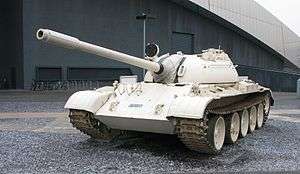Bore evacuator
A bore evacuator or fume extractor is a device on the gun barrel of an armoured fighting vehicle which helps prevent poisonous propellant gases from venting back into the vehicle's fighting compartment when the gun breech is opened to load another round. Bore evacuators are most often used on large-calibre tank guns and self-propelled guns. Without bore evacuators, hot gases and other combustion residue leaks into the tank's interior, depleting oxygen levels and filling it with a foul odour that can easily induce nausea and distract the crewmen from their tasks.[1]

The evacuator is a simple passive device. It consists of a ring of holes drilled into the barrel, surrounded by a cylindrical pressure reservoir. As the shell moves down the barrel during firing, it reaches a point where the base of the shell passes the set of holes. The high-pressure propellant gases in the barrel behind the shell blow into the pressure reservoir through these holes, charging it with gas. As the shell continues down the barrel the pressure begins to drop, and then suddenly returns to near atmospheric pressure as the shell leaves the barrel. During this process the high-pressure gas in the reservoir begins to blow back into the barrel. By aiming these holes forward, their exhaust causes the gases to be blown down and out of the barrel.[2]
Various designs attempt to improve on the basic concept in any number of ways. One common change is to use two sets of holes, each designed specifically to be efficient at capturing or releasing the gas. In this case the forward set of holes is similar to the single-hole example, but a second rearward set of holes is added, using check valves (typically ball bearings in a pit) to allow the high-pressure gases in, but not out again. The system may be arranged to allow the gases to escape through the forward set of holes before the shell reaches it, causing a partial vacuum to develop directly behind the shell, aiding extraction.[2]
For best results, the breech must be opened at the proper time, just as the forward momentum of the gases reaches its maximum, the peak flow. This means that bore extractors are normally used only on guns with semi-automatic or fully automatic actions, where the breech is opened and the shell ejected as part of the recoil process.

Extractors reduce the chances of these explosive propellants flowing backwards into the turret, causing combustion as they mingle with oxygen, though this can still happen if the evacuator is poorly designed, poorly maintained, or damaged. Unprotected bore evacuators damaged by bullets have caused considerable problems in past conflicts, but up-armouring solved this problem.
Bore evacuators are a common feature of most modern tanks. The Russian T-14 Armata tank does not have a fume extractor as it has an unmanned turret.
References
- ↑ Perrett, Bryan (1987). Soviet Armour Since 1945. London: Blandford Press. ISBN 0-7137-1735-1.
- 1 2 "Engineering Design Handbook; Guns Series, Muzzle Devices", AD838748, US Army
External links
| Wikimedia Commons has media related to Bore evacuators. |
- Woodley, C.R. (May 2001), "Modelling of Fume Extractors" (PDF), 19th International Symposium of Ballistics, Interlaken, pp. 273–280, retrieved 2014-01-07
- Pei, Qing-Xiang; Foo, Richard (May 2001), "Modeling and Simulation of the Gas Charging and Discharging Processes on Gun Bore Evacuator" (PDF), 19th International Symposium of Ballistics, Interlaken, pp. 281–288, retrieved 2014-01-07